I’ve been trying to send emails in Symfony for the past few weeks, and I’ve finally nailed it.
So, I decided to write a comprehensive “Symfony send email” article with code examples you can re-use.
First, I’ll configure the new Mailer and Mime components, which were introduced in the Symfony 4.3. release. Thanks to these two components, Symfony now has an internal email-sending system with a wide set of options, including:
- CSS inliner
- Twig templates
- File attachments
- Signing and encrypting messages
- Direct integration with the most popular email-sending providers
- Asynchronous email sending with Symfony Messenger
Then, I’ll show you how I configured Mailtrap, so you can send emails with either SMTP or API.
Let’s begin!
Note: In this tutorial, I’ll use Symfony 7.0.
Setting up Symfony Mailer
To create and send messages in Symfony, we first need to install the Mime and Mailer components with the following command:
Then, to create a message, I autowired the mailer with the MailerInterface, specified the components I was going to use, and created an Email object.
To send an email, you can go to “http://<your-app-url>/email” or use “http://127.0.0.1:8000/email” in development.
The route accessible from the web is created with the help of @Route:
Additionally, you can play around with Mailer, as it’s straightforward and gives you room for flexibility and experimentation. For example, you can set email addresses in several ways because both strings and addresses are supported.
To set from() address, you can use either:
You can use the same principles to add recipients with Cc, Bcc, ReplyTo, and multiple addresses, like so:
If you’re interested in more details and alternatives, refer to the corresponding section in the Symfony Mailer documentation.
How to send email using SMTP
To start sending emails, you need to set up your SMTP configuration.
Of course, for my sending purposes, I used the Mailtrap email delivery platform. It was an obvious choice as it offers higher deliverability rates than other options on the market, plus it’s easy to set up.
First, register an account and verify your email-sending domain.
Then, go to the API and SMTP tab in the Sending Domains section, where you’ll find the settings you need to send emails.

Here, as you can see, you have two options: Transactional and Bulk streams. For this chapter, we’ll use the Transactional Stream, and I’ll cover sending Bulk Stream later.
If you’ve successfully installed Mailer and Mime components, you should be able to find them in the .env file. There, you need to add the Transactional Stream credentials provided by Mailtrap in the MAILER_DSN section.
It should look something like this:
Once you’ve configured Symfony Mailer and Mailtrap SMTP, you can test the email-sending functionality with the mailer:test command:
Note:
- Make sure the domain of the sender’s email address matches the domain you register with Mailtrap.
Send HTML email
To send HTML, simply add the HTML part directly to the email object:
Note:
- Don’t forget to also include the text part for clients that don’t support HTML emails.
- For more in-depth HTML customization in Symfony, check out our dedicated article.
Twig templates
Additionally, you can use Twig templating, which is integrated with the Mime component and offers you a wide set of options, including CSS inlining and direct integration with HTML/CSS frameworks.
Once you create a template and save it as a .twig file, instruct the Mime component to render email content from that file with the TemplatedEmail class:
I found Twig templates useful because they offer support for other frameworks, which you can install as extensions:
MarkdownExtensionfor MarkdownInkyExtensionfor Foundation for Emails (earlier it was called Inky)CssInlinerExtensionfor CSS inlining
For more details on creating email templates with Twig, refer to the Symfony documentation: Twig section and Templates section.
How to send email to multiple recipients
For sending email to multiple recipients, I used the following code:
Send email with attachments
To attach files to email, I used the attachFromPath() method to include files hosted locally or from an external link and attach() for reading files from a stream.
Check it out:
When sending emails with attachments, make sure that the allow_url_fopen setting is enabled in your PHP configuration, as it’s necessary for Symfony to read files from URLs.
Sending email with an embedded image
In Symfony Mailer, you can either embed images with direct embedding using embed argument or CID attachment.
If you go with the CID route, simply refer to your image in the message body by setting its Content-ID and using a standard HTML tag.
Here’s an example:
Just make sure that paths and IDs match your actual files and identifiers.
Asynchronous email sending
To integrate asynchronous email sending, we will need Symfony Messenger, which you can add using Composer with the following command:
Then, define a transport in config/packages/messenger.yaml that will be used to queue your email messages. For this, you can use various backends (e.g., Doctrine, Redis, RabbitMQ, etc.).
As an example, we’ll use Doctrine database as the transport:
Once you define a transport, set the MESSENGER_TRANSPORT_DSN in your .env file to use Doctrine, like so:
Note:
- If you want to use Redis, simply modify the line in your .env file for the Messenger transport DSN to this:
- If you want to use RabbitMq, change it to this:
Here’s an example of how you can modify sendEmail method in your MailerController:
But, to actually send the emails, run a worker that listens to the queue and processes the messages with the following command:
How to send bulk email
Mailtrap also helped me send bulk emails in Symfony as it offers Bulk Stream, which you can find in the SMTP/API Settings tab when you log into your account.
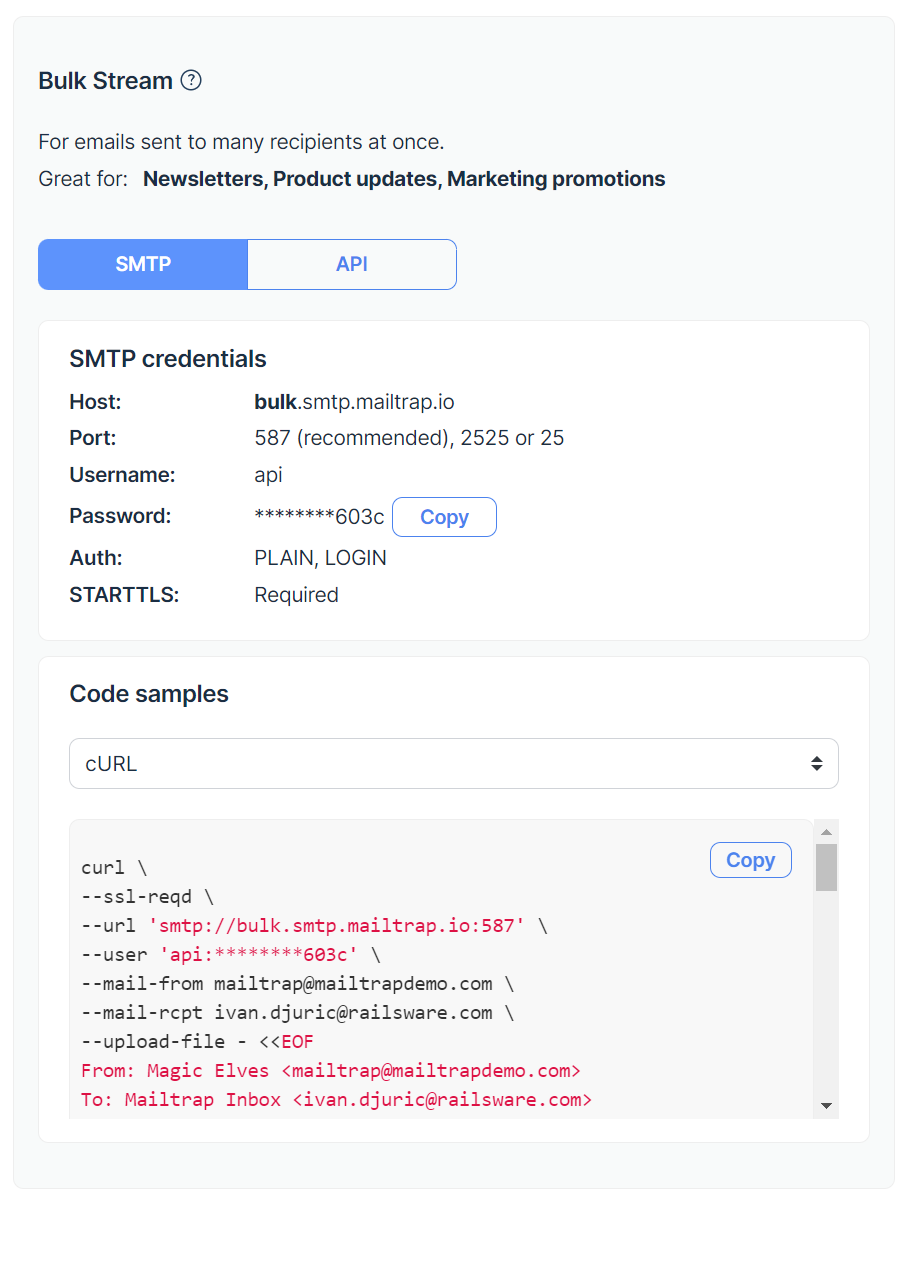
First, I replaced my transactional email Mailtrap credentials with the Bulk Stream ones in the MAILER_DSN method.
Then, I created the EmailSender service that can send bulk email, which looks like this:
How to send email using API
If you haven’t already, register an account and verify your email sending domain name.
Navigate to the API and SMTP tab in the Sending Domains section. There, you will find your API key/token.
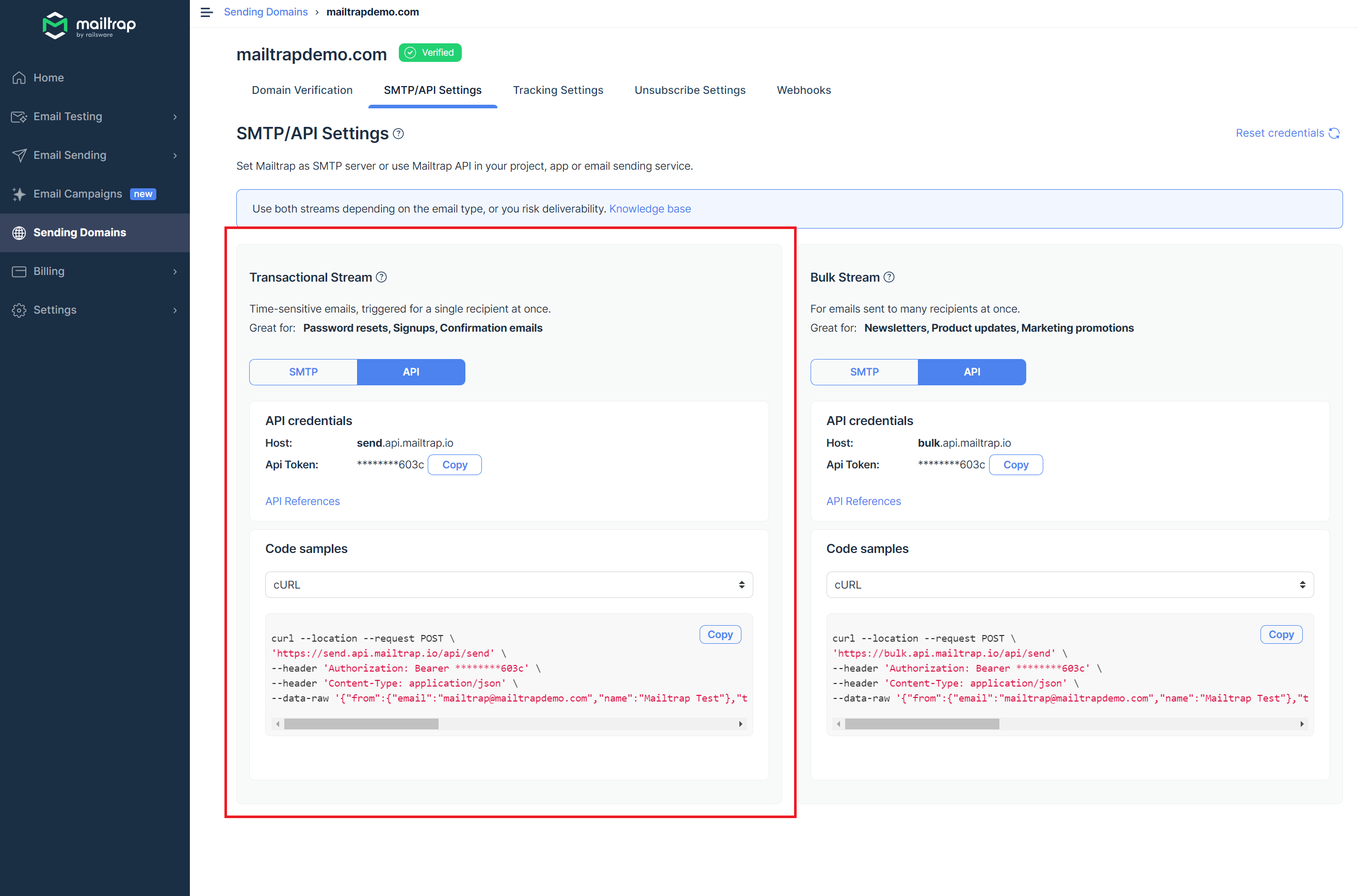
Now, another benefit of Mailtrap I haven’t mentioned yet is that the platform offers a PHP client, which allows you to easily integrate Mailtrap with your Symfony-based application.
As you can see in the screenshot, I again used the Transactional API. So, simply click on API and store your token credentials.
Then, you need to add MailtrapTransport into your config/service.yaml file:
And lastly, simply copy your credentials inside your .env file and copy your API key into the same block:
To test:
Note: Make sure that the email matches with the registered domain email.
For more information, check out the official documentation for Symfony framework bridge on GitHub. Or, better yet, learn how to master Symfony’s Mailer and easily integrate Mailtrap in the course released by Symfony Casts. 👀
Send HTML email
To send HTML email, all I did was add the HTML part directly to the email object, like so:
Twig templates
As with SMTP, you can use Twig templates if you go with the API route.
Simply create a template, save it as a .twig file, and instruct the Mime component to render email content from that file. For this, you can use the TemplatedEmail class:
How to send email to multiple recipients
Here’s a code example of how I managed to send email to multiple recipients with a Mailtrap API configuration:
Send email with attachments
Similar to sending attachments with Mailtrap SMTP configuration, with the attachFromPath() method, I included files hosted locally or from an external link and used attach() for reading files from a stream.
Check it out:
Of course, don’t forget to ensure the allow_url_fopen setting is enabled in your PHP configuration, without which Symfony won’t be able to read files from URLs.
Sending email with embedded images
Sending email with embedded images with an API configuration is similar to sending them through SMTP.
You can either do it with direct embedding using embed argument or CID attachment. Just don’t forget to check whether the paths and IDs match the actual files and identifiers.
Asynchronous email sending
To integrate asynchronous communication, we will again have to use Symfony Messenger and Doctrine as an example.
You can use this command to install Symfony Messenger:
Then, let’s define a transport in config/packages/messenger.yaml that will be used to queue your email messages.
Again, we’ll be using Doctrine:
Once you define a transport, set the MESSENGER_TRANSPORT_DSN IN YOUR .env file to use Doctrine, like so:
Check out an example of how you can modify sendEmail method in your MailerController:
Lastly, to send a message, you will need to run a worker that listens to the queue and processes the messages with the following command:
How to send bulk emails
To send bulk emails with Mailtrap API configuration, you first need to navigate to the SMTP/API Settings tab in your account and select API in the Bulk Stream window.
There, you will find the host and API Token, which you will replace in your .env file.
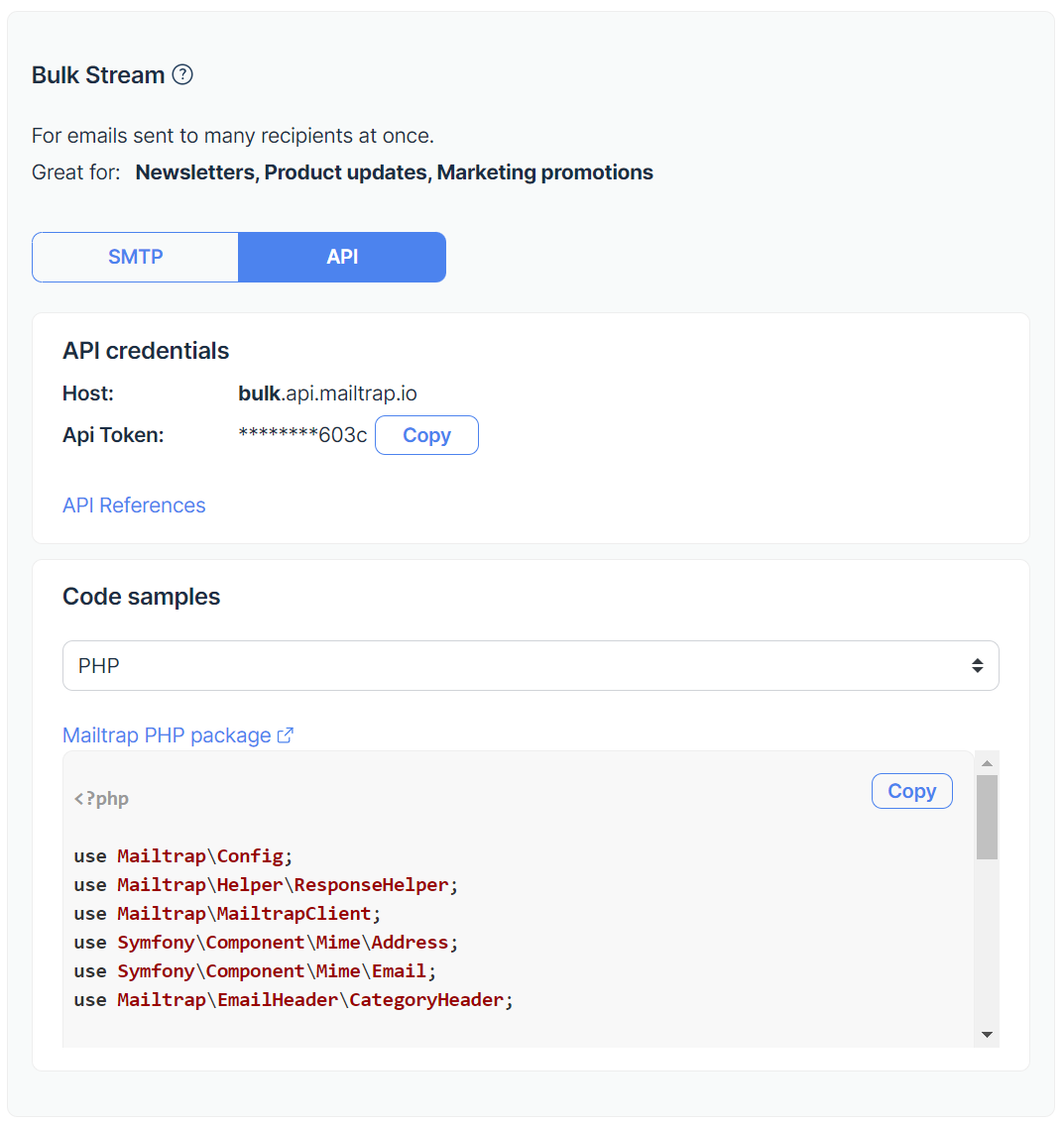
Here’s what your .env file should look like:
And as with an SMTP configuration, you can use Twig templates:
Important functionality and troubleshooting
- Firewall and network – If you’re encountering connectivity issues, make sure that your firewall or network policies aren’t blocking outgoing connections on the port used by Mailtrap.
- Sending secure messages – Symfony lets you both sign and encrypt emails with the S/MIME standard. You only need a valid S/MIME certificate and the configured OpenSSL PHP extension.
- SSL/TLS connection – To ensure your data is encrypted during transmission, specify
encryption=ssl/tlsin the .env configuration for Mailtrap. For example:
Test emails before sending
Now that we have everything in place and set up, it’s time to test if everything works as intended because whether you’re using an SMTP or an API configuration to send emails, many things can go wrong.
For example, your HTML might not render properly by web browsers, or your personalization variables may be off. Moreover, your emails might be skipping inboxes or getting marked as spam.
To avoid these issues and improve your email deliverability, you can use a platform like Mailtrap Email Testing, which can help you inspect and debug your emails in a safe environment.
Mailtrap Email Testing helps you catch traffic from staging and dev environments and then preview them and analyze their HTML/CSS before you send them out to your recipients.
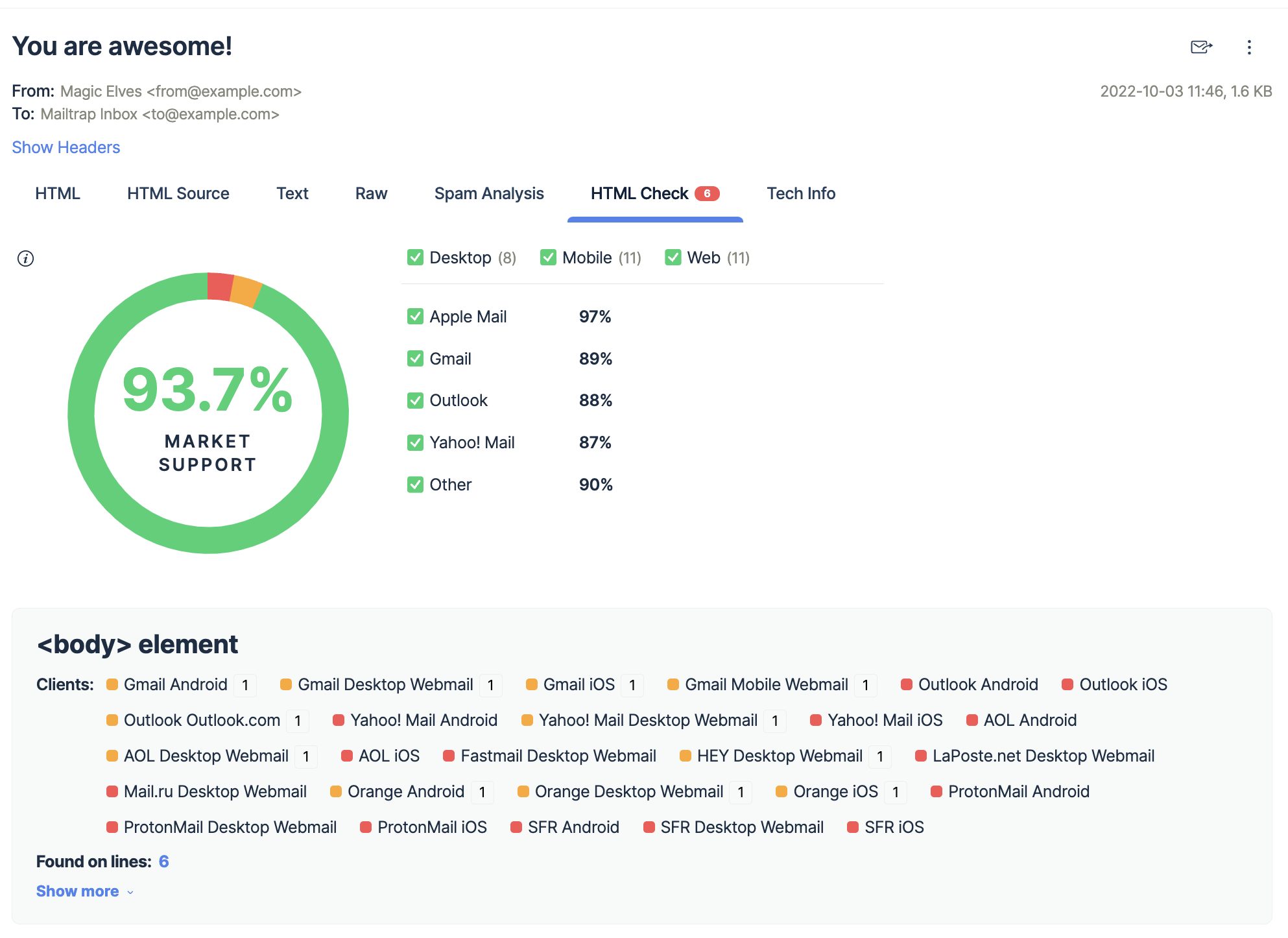
You can also check the spam score of your emails before you send them, which, if you keep below 5, can solve many potential deliverability issues.
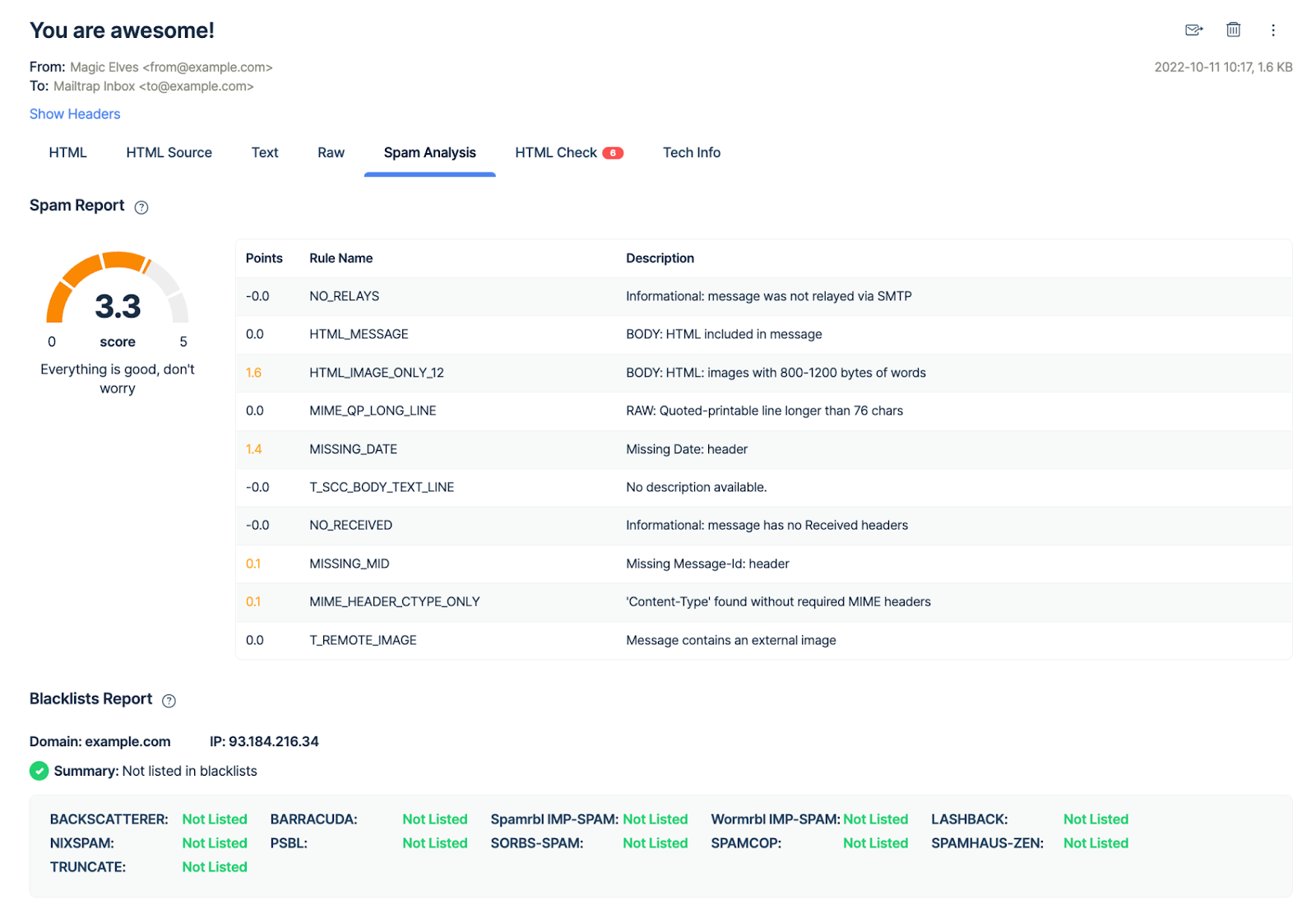
Additionally, Mailtrap lets you easily create new projects, add multiple objects within, and share the testing process with your team members.
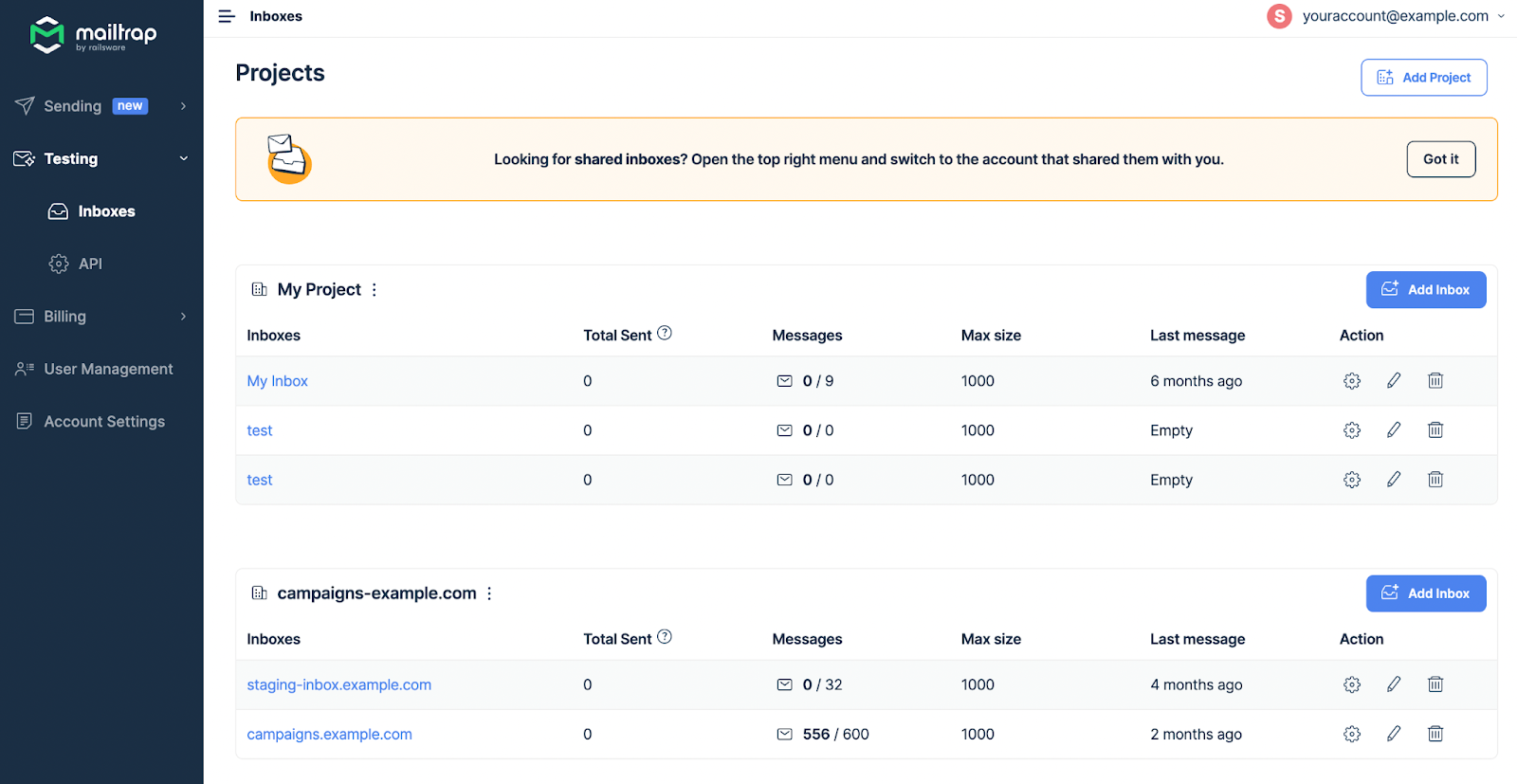
Lastly, Mailtrap Email Testing is quite easy to set up, and you can test emails with it regardless of whether Mailtrap is a sending solution or SendGrid, Amazon SES, or Mandrill (now Mailchimp Transactional Email).
SMTP
To start testing with a fake SMTP server, you first need to change your MAILER_DSN and update it with the Mailtrap Email Testing SMTP credentials, so it looks something like this:
Then, you can use the following code snippet, which includes both HTML and plain text parts, with a PDF file and an embedded image to test your email:
In the following example, I used the Mailer class to send the message and included both HTML and plain text parts, with a PDF file and an embedded image:
Then I checked the Mailtrap virtual inbox after a few moments and received the following message:
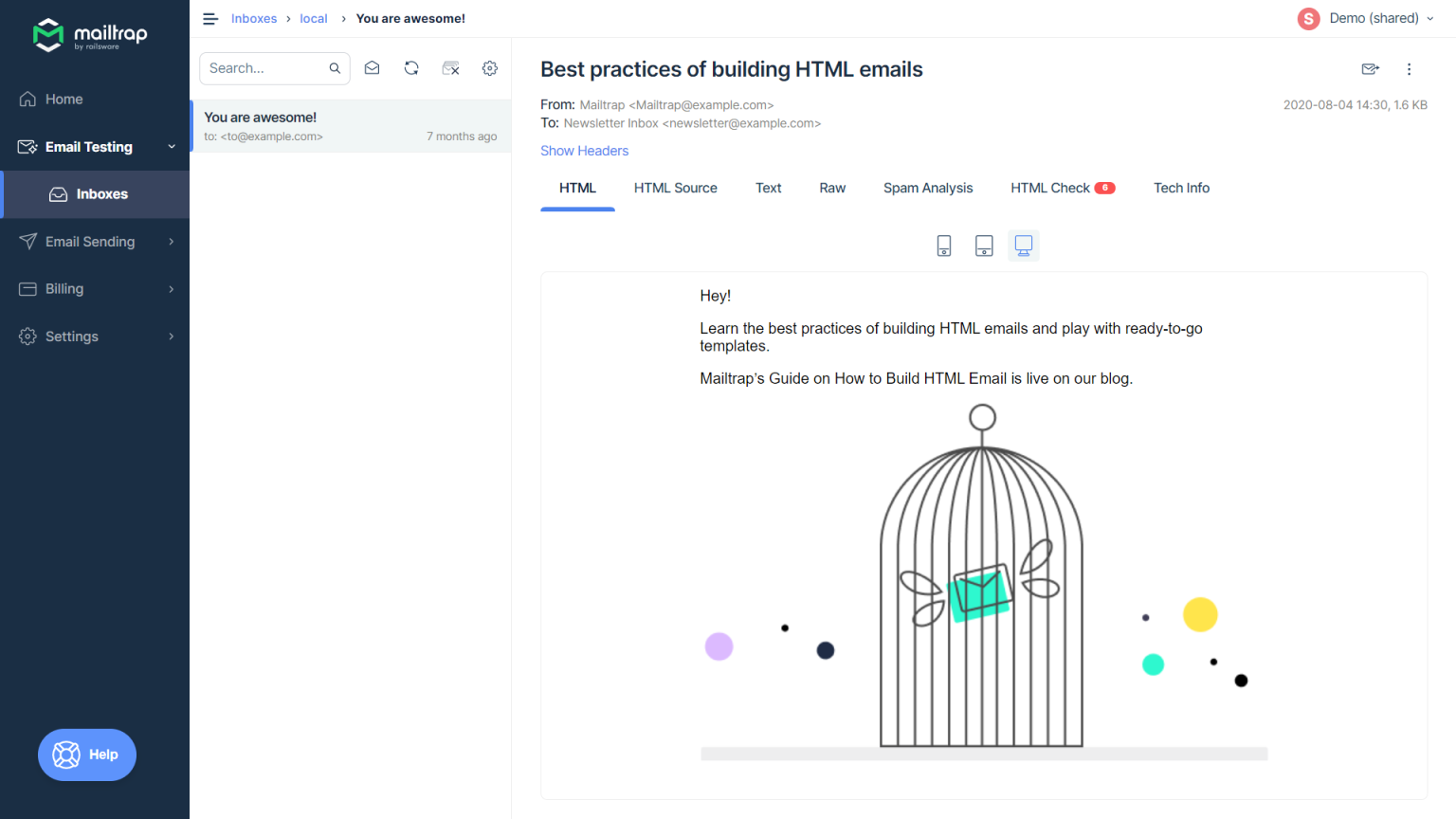
Success!
API
Now, if you want to integrate Mailtrap Email Testing API for testing automated sequences, you need to have a custom transport configured as described. Your setup should look like this:
Then again, you can use a code snippet with an HTML, PDF, and an embedded image:
Pro Tip: You can use the Testing API for Testing and QA automation.
Wrapping up
And with that, we’ve come to the end of our ‘symfony send email’ article!
Regardless of whether you want to use SMTP or API configuration to send emails in Symfony, you can use this article as your go-to resource.
Interested in learning more? Our Full Stack developer, Dmitriy, has written an excellent guide on Sending Emails with Swift Mailer Library, which Symfony’s mailer feature was initially based on.
Or, you can read other articles from our blog, such as:




